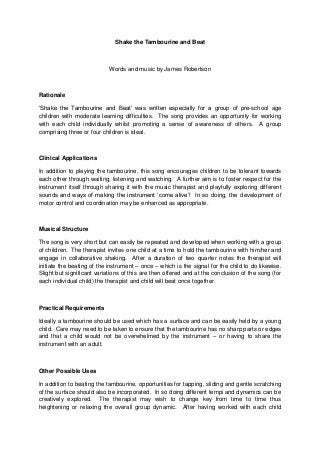
Shake the Tambourine and Beat
- 1. Shake the Tambourine and Beat Words and music by James Robertson Rationale ‘Shake the Tambourine and Beat’ was written especially for a group of pre-school age children with moderate learning difficulties. The song provides an opportunity for working with each child individually whilst promoting a sense of awareness of others. A group comprising three or four children is ideal. Clinical Applications In addition to playing the tambourine, this song encourages children to be tolerant towards each other through waiting, listening and watching. A further aim is to foster respect for the instrument itself through sharing it with the music therapist and playfully exploring different sounds and ways of making the instrument ‘come alive’! In so doing, the development of motor control and coordination may be enhanced as appropriate. Musical Structure The song is very short but can easily be repeated and developed when working with a group of children. The therapist invites one child at a time to hold the tambourine with him/her and engage in collaborative shaking. After a duration of two quarter notes the therapist will initiate the beating of the instrument – once – which is the signal for the child to do likewise. Slight but significant variations of this are then offered and at the conclusion of the song (for each individual child) the therapist and child will beat once together. Practical Requirements Ideally a tambourine should be used which has a surface and can be easily held by a young child. Care may need to be taken to ensure that the tambourine has no sharp parts or edges and that a child would not be overwhelmed by the instrument – or having to share the instrument with an adult. Other Possible Uses In addition to beating the tambourine, opportunities for tapping, sliding and gentle scratching of the surface should also be incorporated. In so doing different tempi and dynamics can be creatively explored. The therapist may wish to change key from time to time thus heightening or relaxing the overall group dynamic. After having worked with each child
- 2. individually the therapist can then choose to open out the song by offering the instrument in a more random manner to the children, thereby incorporating spontaneity and the element of surprise. The song can be used with children who are older than pre-school age. A further variation may include one child holding the tambourine for another child; to an extent, therefore, the child taking the role of the therapist.